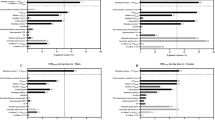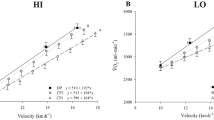Abstract
The present study investigated whether there are differences in running economy at different velocities for well-trained distance runners, and to what extent a commonly used incremental protocol for measuring oxygen uptake (VO2) at different velocities affects the reliability of these measurements. Fifteen well-trained distance runners (9 male and 6 female) participated in this study. Gross oxygen cost of running (C R), heart rate (HR) and [La−]b during 5-min runs at velocities ranging from 8.0 to 17 km h−1, representing intensities ranging from 60 to 90% of maximal oxygen consumption (VO2max) was measured on two different days in random order. The athletes were also tested for lactate threshold, VO2max and time to exhaustion at MAS (tMAS). No significant differences in C R between the different relative velocities or the different set velocities were found up to 90% of VO2max. The incremental protocol for measuring VO2 at different velocities was found not to affect the reliability of these measurements. All athletes reached their VO2max whilst running to exhaustion at MAS. The females showed significantly lower VO2max, but significantly better C R than the males. At velocities representing intensities between 60 and 90% of VO2max, no differences in C R were found. The commonly used incremental protocol for measuring oxygen uptake (VO2) at different velocities was found not to affect the reliability of these measurements. This means that C R measured at sub-maximal velocities are representative for C R at race velocity for distances above 10,000 m for most runners.


Similar content being viewed by others
References
Åstrand PO, Rodahl K (1986) Textbook of work physiology. McGraw-Hill, New York
Bassett FA, Chouinard R, Boulay MR (2003) Training profile counts for time-to-exhaustion performance. Can J Appl Physiol 28(4):654–666
Berg K (2003) Endurance training and performance in runners: research limitations and unanswered questions. Sports Med 33(1):59–73
Bergh U, Sjődin B, Forsberg A, Svedenhag J (1991) The relationship between body mass and oxygen uptake during running in humans. Med Sci Sports Exerc 23(2):205–211
Billat LV, Koralsztein JP (1996) Significance of the velocity at VO2max and time to exhaustion at this velocity. Sports Med 22:90–108
Bunc V, Heller J (1989) Energy cost of running in similarly trained men and women. Eur J Appl Physiol Occup Physiol 59(3):178–183
Conley DL, Krahenbuhl GS (1980) Running economy and distance running performance of highly trained athletes. Med Sci Sports Exerc 12(5):357–360
Costill DL, Thomas H, Roberts E (1973) Fractional utilization of the aerobic capacity during distance running. Med Sci Sports Exerc 5:248–252
Daniels J, Daniels N (1992) Running economy of elite male and elite female runners. Med Sci Sports Exerc 24(4):483–489
Di Pampero PE, Atchou G, Brückner JC, Moia C (1986) The energetics of endurance running. Eur J Appl Physiol 55:259–266
Eisenmann JC, Pivarnik JM, Malina RM (2001) Scaling peak VO2 to body mass in yong male and female distance runners. J Appl Physiol 90:2172–2180
Farell PA, Wilmore JH, Coyle EF, Billing JE, Costill DL (1979) Plasma lactate accumulation and distance running performance. Med Sci Sports Exerc 11(4):338–344
Helgerud J (1994) Maximal oxygen uptake, anaerobic threshold and running economy in women and men with similar performance level in marathons. Eur J Appl Physiol 68:155–161
Helgerud J, Ingjer F, Strømme SB (1990) Sex differences in performance-matched marathon runners. Eur J Appl Physiol 61:433–439
Helgerud J, Engen LC, Wisløff U, Hoff J (2001) Aerobic endurance training improves soccer performance. Med Sci Sports Exerc 33(11):1925–1931
Helgerud J, Kemi OJ, Hoff J (2003) Pre-season concurrent strength and endurance development in elite soccer players. In: Hoff J, Helgerud J (eds) Football (Soccer) new developments in physical training research. NTNU, Trondheim
Hoff J, Helgerud J (2003) Maximal strength training enhances running economy and aerobic endurance performance. In: Hoff J, Helgerud J (eds) Football (Soccer) new developments in physical training research. Norwegian University of Science and Technology, NTNU, Trondheim, pp 37–53
Hoff J, McMillan K, Helgerud J (2005) Football (Soccer) specific, simple, low cost, test of endurance performance and maximal oxygen uptake. Doctorial thesis at Norwegian University of Science and Technology, Trondheim, Norway, p 184
Lacour JR, Padilla-Magunacelaya S, Barthelemy JC, Dormois D (1990) The energetics of middle-distance running. Eur J Appl Physiol 60:38–43
Morgan DW, Baldini FD, Martin PE, Kohrt WM (1989) Ten kilometer performance and predicted velocity at VO2max among well-trained male runners. Med Sci Sports Exerc 21:78–83
Morgan DW, Bransford DR, Costill DL, Daniels JT, Howley ET, Krahenbuhl GS (1995) Variation in the aerobic demand of running among trained and untrained subjects. Med Sci Sports Exerc 27:404–409
Noakes TD, Myburgh KH, Scall R (1990) Peak treadmill running velocity during the VO2max test predicts running performance. J Sports Sci 8(1):35–45
Pate RR, Kriska A (1984) Physiological basis of the sex difference in cardiorespiratory endurance. Sports Med 1:87–98
Pollock ML (1977) Submaximal and maximal working capacity of elite distance runners. Part 1: Cardiorespiratory aspects. Ann N Y Acad Sci 301:310–322
Conflict of interest statement
There is no conflict of interest.
Author information
Authors and Affiliations
Corresponding author
Additional information
Communicated by Susan Ward.
Rights and permissions
About this article
Cite this article
Helgerud, J., Støren, Ø. & Hoff, J. Are there differences in running economy at different velocities for well-trained distance runners?. Eur J Appl Physiol 108, 1099–1105 (2010). https://doi.org/10.1007/s00421-009-1218-z
Accepted:
Published:
Issue Date:
DOI: https://doi.org/10.1007/s00421-009-1218-z




